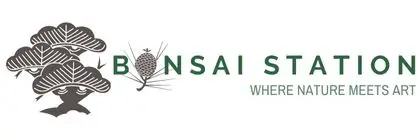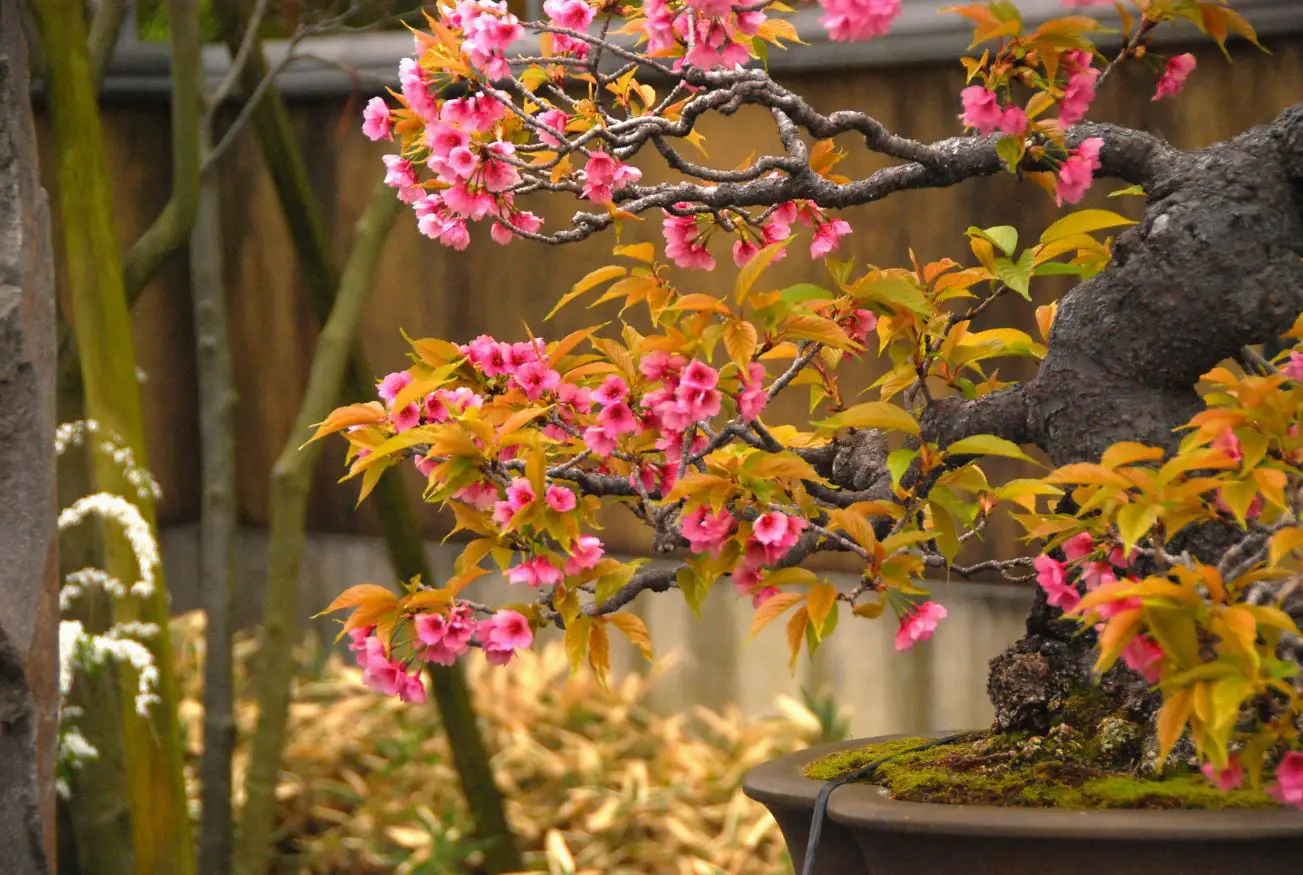Choosing the right cherry blossom bonsai species
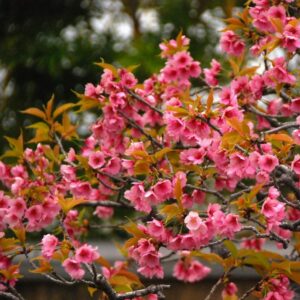
Characteristics of good cherry blossom bonsai
Cherry blossom species that make good bonsai show specific characteristics that contribute to their suitability for cultivation in miniature form. These characteristics include the followings.
Beauty of flowers
Beauty
The beauty of flowers is a crucial characteristic of a cherry blossom bonsai. The stunning and captivating blossoms are one of the primary reasons you might be drawn to cherry blossom bonsai.
Flower size
Smaller flowers are more suitable for bonsai as they complement the miniature scale of the tree and its container. When selecting a cherry blossom species for bonsai making, it’s beneficial to choose varieties that naturally have smaller flowers.
Flowering abundance
Cherry blossom species that produce abundant flowers are desirable for bonsai cultivation.
Compact growth habit
Bonsai-friendly cherry blossom varieties have naturally compact growth habits, making it easier to shape and maintain their form within the constraints of a small container.
Elegant bark
A well-textured trunk with interesting bark patterns adds to the visual appeal of a cherry blossom bonsai. These features contribute to the tree’s character and authenticity.
Ramification potential
Cherry blossom species that readily develop ramification create a more refined and mature appearance.
Best cherry blossom bonsai species
Several cherry blossom species are well-suited for bonsai cultivation based on the characteristics mentioned above. Here are a few cherry blossom species that are popular choices for bonsai making due to their beautiful flowers, small leaves, compact growth habits, ramification potential, and overall suitability for miniature forms.
Fuji cherry (Prunus incisa)
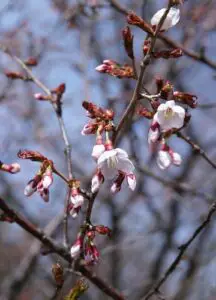
Fuji cherry
(source: 四季の山野草)
Fuji cherry has a compact growth habit as well as smaller flowers, making it an excellent choice for bonsai cultivation. It is one of the wild cherry species native to Japan. The name “Fuji” cherry comes from its native region in Japan: around Mount Fuji.
Fuji cherry exhibits greater resistance to cold temperatures compared to typical cherry blossoms and can endure temperatures as low as 5°F (-15°C) (flower buds tolerating down to 20°F (-7°C)).
Weeping cherry (Cerasus itosakura)
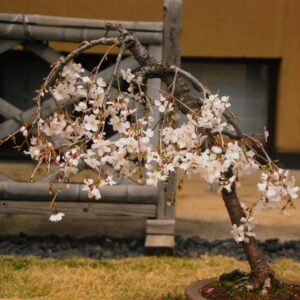
Weeping cherry bonsai
Weeping cherry trees can make beautiful and captivating bonsai. The graceful cascading branches and delicate pendulous flowers of weeping cherries add an elegant and unique character to bonsai compositions.
It’s worth noting that a weeping cherry is not a species or cultivar but is a common name used for cherry blossom trees that have gentle, hanging branches. Weeping cherry trees can include both naturally occurring varieties as well as different variations like hybrids resulting from wild species and cultivated varieties.
Since weeping is genetically recessive, some of the propagated trees might not display the characteristic drooping branches even when parents weeping cherries are bred.
Cherry blossom bonsai care
Cherry blossom bonsai care at a glance
| Cold tolerance | Strong |
| Heat tolerance | Strong |
| Drought tolerance | Fairly low |
| Sun exposure | Full sun |
| Soil mix | Akadama/volcanic sand: 50% Pumice: 30% Organic compost: 20% |
| Watering | 2 /day in spring and fall 2-3 times/day in summer Once every 2-3 days in winter |
Placing: indoor or outdoor?
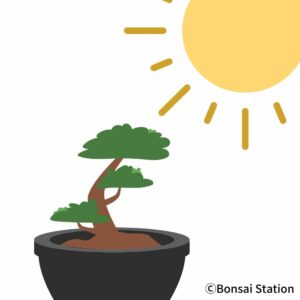
Providing the right balance of sunlight is paramount to the health and vigor of your cherry blossom bonsai.
Sunlight Requirements
Full sun exposure
Place your cherry blossom bonsai where it receives at least 6 to 8 hours of sunlight each day. Cherry blossom bonsai trees thrive in bright, direct sunlight. When placed in shade, it struggles to form flower buds and its branches often become weak and frail.
Summer shade for smaller varieties
That said, smaller varieties including Fuji cherry are sensitive to intense sunlight and heat. They can be damaged by slight fluctuations in water levels, either too little or too much. Severe leaf damage not only the loss of next year’s blossoms but also risks the tree’s survival.
To avoid strong summer sunlight, provide shade for smaller varieties during summer.
Indoor or outdoor?
Cherry blossom bonsai is an outdoor plant.
Cherry blossom trees are naturally adapted to outdoor environments and I wouldn’t recommend placing your cherry blossom bonsai indoors. Lack of adequate sunlight may likely cause less blooming.
Cherry blossom bonsai trees thrive when they receive full sun all day and indoor conditions often fall short of providing the intensity and duration of light they require.
If you choose to grow cherry blossom bonsai indoors, it’s crucial to place it at the south-facing window (not NEAR) and provide supplemental artificial lighting to mimic the intensity and duration of natural sunlight.
Repotting
How often to repot
Generally, it’s recommended to repot young cherry blossom bonsai trees every 1 to 2 years and more mature trees every 2 to 3 years to maintain healthy growth.
Cherry blossom roots tend to grow vigorously. If you don’t repot them regularly, the roots get root-bound, resulting in fewer flowers and stunted growth.
When to repot
The optimal period for repotting cherry blossom bonsai is right after they’ve bloomed and before the new spring buds appear, which is from March to April depending on species and climate. Repotting during this timeframe ensures minimal stress on the tree and allows the roots to regrow quickly from robust root cuts.
Make sure to provide protection from cold until the temperature becomes warm. It can be still chilly during this season, with the possibility of spring frosts. New leaves and leaf buds are susceptible to cold damage after repotting.
You can also repot in early fall if you live in a warmer climate. Provide protection if you repot in the fall because the tree can be easily damaged by winter cold.
Best soil mix for cherry blossom bonsai
The best soil mix for cherry blossom bonsai is;
-
- Akadama/volcanic sand: 50%
- Pumice: 30%
- Organic compost: 20%
The soil should have good water retention as well as drainage.
How to repot
Step 1
Pull the tree out of the pot and loosen most of the old soil, first from the bottom and then from around the edges.
Step 2
Prune 1/3 of thick/old roots while avoiding cutting fine roots so that new fine roots can grow. It is important to always use clean, sterile scissors when cutting cherry blossom roots as there is a risk of pathogens entering through the cut. You can also apply an antibacterial agent to the cut for extra protection.
Step 3
Put a layer of large grain soil (eg. pumice) on the bottom of the pot to make sure the soil keeps good drainage.
Step 4
Place the tree in the pot and fill it with soil mix.
After repotting, water well and move the tree to a shaded place with little wind for 1 to 2 weeks until it takes root. During this time, make sure not to let the soil dry out, and water it before it completely dries out.
Watering
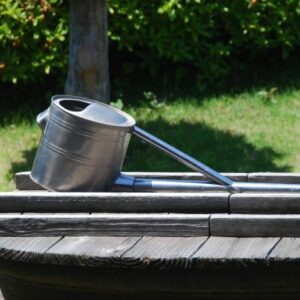
Proper watering is an essential pillar of cherry blossom bonsai care, ensuring the tree’s vitality, growth, and ability to produce beautiful and delicate blooms.
As a general guide, cherry blossom bonsai should be watered;
- Twice/day in spring and fall
- Twice or three times/day in summer
- Once every 2 to 3 days in winter
Cherry blossom bonsai require abundant water as they have relatively large leaves as bonsai trees. Watering during summer is particularly crucial to prevent severe leaf burn, which may negatively affect growth and flower bud development.
When watering, make sure that water seeps through the entire root system. Water until you see it draining from the bottom of the pot. Having said that, avoid overwatering as well.
Having large leaves, simply watering from above might not be enough to adequately moisten the soil because the leaves may prevent water to reach the soil. Make sure to water not only the leaves but also the root area of the tree.
Fertilizing
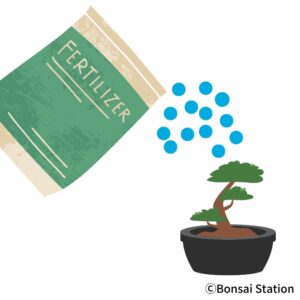
When to fertilize
Spring
Cherry blossom bonsai has a high demand for fertilizer for flowering, and continuous fertilizing is vital throughout the growing season.
Start fertilizing in early spring. After bloom, give your bonsai plenty of fertilizer as it is important for maintaining branching and tree shape. From April to June, it’s recommended to apply fertilizer at a much higher rate compared to other tree species.
That said, it’s safer to apply smaller amounts of fertilizer more frequently to avoid the risk of fertilizer burn.
When repotted, stop fertilizing for about two weeks before gradually starting fertilization again.
Summer
Stop fertilizing during summer as your bonsai doesn’t absorb as much nutrients when it is hot.
Fall
Start fertilizing again from late August/September until October when leaves start to change color. This is essential as a key nutrient for winter dormancy.
Winter
You don’t need to fertilize during winter as your bonsai is dormant.
Which fertilizer to use
Choose a fertilizer with a higher middle and last number in the N-P-K ratio, indicating a significant phosphorus and potassium content. The following product from Amazon is a slow-release bonsai bloom fertilizer with an N-P-K ratio of 6-8-10 and is perfect for your cherry blossom bonsai.
You can also choose a balanced bonsai fertilizer that will give ideal growth for all bonsai trees including cherry blossom bonsai trees. (N-P-K ratio is 12-11-10 for the following product.)
When giving fertilizer, make sure no excess nitrogen remains in the soil at the time of flower bud formation in late summer.
Styling
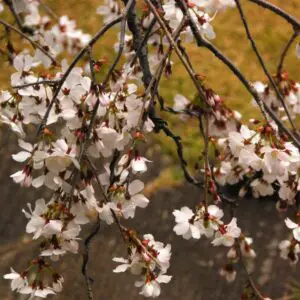
Wiring cherry blossom bonsai
Cherry blossom branches tend to display a pattern of both dying and regrowing repeatedly. Depending on the variety, retaining well-shaped branches in their original state can be a challenge. That said, you can make a good cherry blossom bonsai with the right shaping techniques.
Pinching/pruning
To encourage the growth of fine branches, pinch the tips of branches when 5 to 6 new leaves appear in spring, leaving 2 to 3 leaves. When the next new leaves appear, repeat the process: keep 2-3 leaves and pinch off the rest. The third sprout should be left to grow until they fall off before winter.
Keep in mind that this method of pinching will likely lead to less or no blooming next year, while it is a good way to encourage ramification. If you want to see flowers, a different approach is recommended.
When the new shoots are very short, keep 2-3 nodes and pinch off the rest. Let the second sprout grow. Flower buds will develop on the branches from the second sprout.
Pruning
Pruning of cherry blossom bonsai for basic styling should be done in November after the leaves fall, but before it gets very cold. Light pruning can be done immediately after spring flowering.
Start with larger cuts and gradually work your way to finer details. Look at the flower and leaf buds, and cut off unnecessary branches. If needed, use wire to change the direction of branches.
Avoid hard pruning if possible. Cherry blossom branches are known to die off with hard pruning. But if you have to, cut the unnecessary branches completely at the intersection of the trunk. Don’t leave them half-cut because that part might start to rot.
After pruning, protect the cuts with wound dressing or cut paste (clay-like materials) even if the cut is small. Water might evaporate from the cuts and make the tree weak. Or fungi, viruses or bugs might get in through the cuts. It’s important to do this to keep the tree safe and healthy.
Wiring
Using wires for styling cherry blossom bonsai isn’t the best idea. Cherry blossom branches tend to die off and grow new branches quickly, so wired branches might not stay in the shape you want for a long time. Also, its bark can be easily damaged, which can cause branches to weaken and die anyway.
Instead of relying heavily on wiring, it is better to shape the tree by pinching and pruning branches. Wiring should be more like extra help for cherry blossom bonsai styling, in addition to pinching and pruning.
But if you do want to wire, do it around May to June when new shoots stop growing. To protect the bark, cover the wire or branches with something like raffia. Don’t wire old branches because they have a higher risk of dying. You can wire soft branches that grew this year gently for adjusting the direction.
Be careful if you’re putting on wires late fall because the branches could break easily.
Blooming care
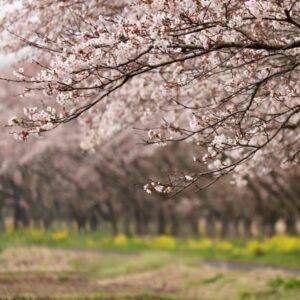
To ensure your cherry blossom bonsai produces abundant and vibrant flowers, it’s important to provide the right care and attention.
-
- Place outside under full sun all day
- Maintain a moderate temperature range: Around 68°F (20°C) is best for flower bud development.
- Give the right fertilizer: Emphasize phosphorous and potassium.
- Avoid pruning in summer: Flower buds are formed in late summer.
- Provide adequate watering: Avoid water shortage.
- Provide protection from cold
For more detailed information about blooming cherry blossom bonsai, I wrote the following article about it which might be helpful.
Defending against infestation
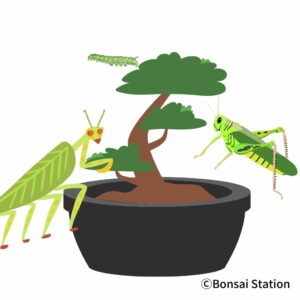
Prevention
Protecting your cherry blossom bonsai from pests and diseases is essential to maintaining its health and vitality. For this, prevention is the key; it is way easier than treating or eradicating pests/diseases once they occur.
Check and monitor your trees regularly. Make sure to look at them from all directions. Provide them with the optimal location and environment. And when acquiring new trees, quarantine them for a period to prevent introducing pests or diseases to your other bonsai trees.
Common cherry blossom pests
Common cherry blossom pests include aphids, mites, caterpillars and bark beetles.
How to treat cherry blossom pests
Here are 3 steps to get rid of bugs on your wisteria bonsai trees:
- Identify bugs
- Use non-chemical option
- Use chemical option
Identify bugs
Familiarize yourself with the common pests that affect cherry blossom bonsai trees in your area. This will help you identify any pests you may encounter.
Non-chemical options
Before using chemicals, there are non-chemical options you can take, including taking them out by hand and pruning affected areas, to get rid of bugs on your bonsai trees. These are easy to do and do no harm to your bonsai trees.
Chemical options
As a chemical option, I would recommend using neem oil for eradicating pests. Neem is a tree native to the Indian subcontinent, which acts as an insect repellent and growth inhibitor. Neem oil is safe for plants as well as humans and works perfectly for my bonsai trees.
Common cherry blossom diseases
Common wisteria diseases include powdery mildew, blight and canker diseases.
How to treat cherry blossom diseases
Here are 3 steps to treat diseases on bonsai trees.
- Identify the disease
- Use non-chemical options
- Use chemical options
Identify the disease
Look for the symptoms of the tree and do research on cherry blossom diseases. Common symptoms include discoloration of leaves, wilting, deformation, cankers, or abnormal growth.
Use non-chemical options
Remove the infested parts carefully using a sterile tool. This may include leaves, branches, or even a part of the trunk if the disease has progressed too far. Do not use your hands because you may touch other trees later, risking the disease to spread.
Use chemical options
Neem oil has antifungal and antibacterial properties that can help control certain bonsai diseases.
If neem oil does not work, identify the problem and choose the right product that can treat the disease. There are many different types of fungicides and bactericides available in the market but not all of them work for the problem with your bonsai.
If you are interested in preventing or treating pests and diseases, please read the following article. It is a complete guide that can help you.
Caring in extreme weather

Cherry blossom is generally quite cold- and heat-tolerant and your bonsai has a remarkable ability to adapt to various weather conditions, including extreme ones.
That said, its delicate fine branches and leaf/flower buds are susceptible to dry winter wind and frost (flower buds can tolerate up to 19°F (-7°C). If the temperature is coming down to this level, provide your bonsai with frost protection by covering it with a frost cloth or bring them to a shed.
Smaller cherry blossom species such as Fuji cherry are sensitive to intense sunlight and heat as well. Even a slight water shortage can harm their roots. During heatwaves, shield your wisteria bonsai from intense sunlight by providing shade to prevent heat stress.
